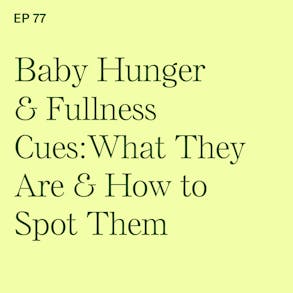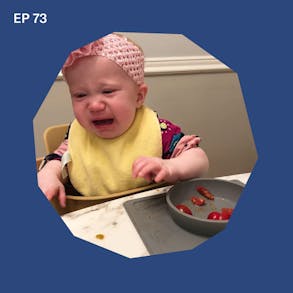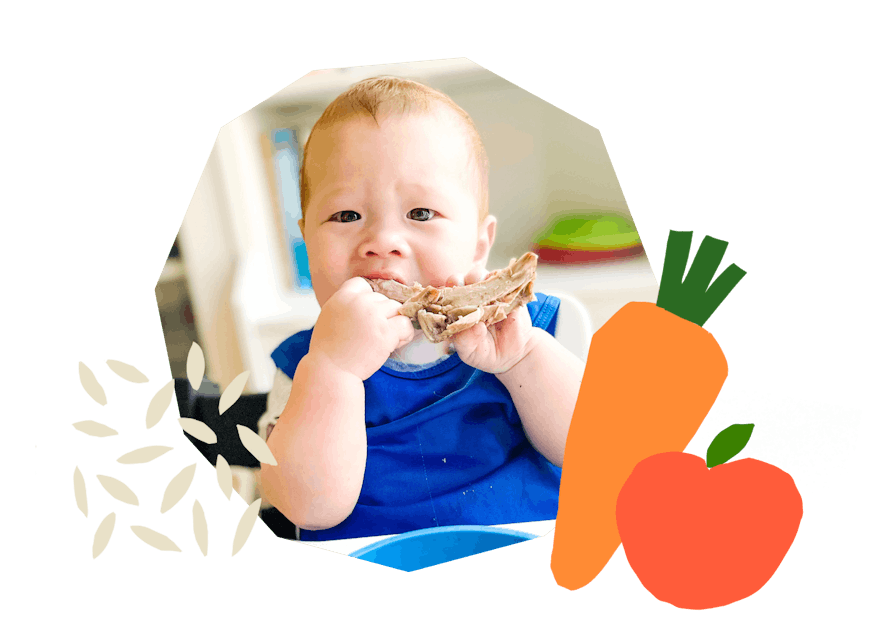BLW Basics: Is My Baby Ready to Start Solid Foods?
- What if my baby isn't sitting independently at or around 6 months of age?
- How do I adjust my baby's age if the baby was born preterm?
- Do all babies lose their tongue thrust reflex before 6 months of age?
- What if my baby is interested in mouthing objects or looking at food before 6 months of age?

LISTEN TO THIS EPISODE
Episode Description
How do I know if my baby is ready to start solid foods with baby-led weaning? What are the reliable signs of readiness to self-feed that we should be looking out for as the baby approaches 6 months? In this episode as part of our BLW Basics series we’re going through the signs of readiness to start solid foods for babies.
Links from this Episode
- Baby-Led Weaning with Katie Ferraro program with the 100 First Foods™ Daily Meal Plan, join here: https://babyledweaning.co/program
- Baby-Led Weaning for Beginners free online workshop with 100 First Foods™ list to all attendees, register here: https://babyledweaning.co/baby-led-weaning-for-beginners
Other Episode related to this topic
- Episode 2: 5 Things Your Baby Should Be Able to Do Before Starting Baby-Led Weaning
- Episode 3: 5 Things Parents & Caregivers Should Do Before Starting Baby-Led Weaning
- Episode 119: Premature Babies: How to Estimate & Adjust Age for Starting Solids
- Episode 109: I Started Purees Too Early: Should I Stop Before Switching to BLW?

Latest Episodes






Katie Ferraro (0s):
And everybody wants to know like the exact number of seconds or minutes that a baby should be sitting unassisted in order to qualify as being ready to eat, or exactly when does the extrusion reflex disappear? And you guys, that sort of data like, there aren't those objective measurements. You've got to go with your gut on this. Hey, there I'm Katie Ferraro, registered dietician, college nutrition professor and mom of seven specializing in baby led weaning here on the baby led weaning made easy podcast. I help you strip out all of the noise and nonsense about feeding, leaving you with the competence and knowledge you need to give your baby a safe start to solid foods using baby led weaning.
Katie Ferraro (42s):
Hey guys, welcome back today. We're going back to the basics. This episode is going to be part of our baby led weaning basics series. We're talking today about "Is my baby ready to start solid foods?" And if you're new here, because if you're listening to an episode named this, you might be, I just wanted to say hi and welcome you. I'm so glad that you're here to learn about baby led weaning and I do two new podcast episodes a week. So every Monday I release a mini baby led weaning training episode like this one. And then every Thursday, I have an interview with a guest feeding expert or author someone from the world of food and feeding in an interview style episode. So, I like to start these mini baby led weaning training episodes with a BLW tip of the day.
Katie Ferraro (1m 28s):
And because we're talking about readiness to feed, I want to remind you in today's tip of the day that not all babies are ready to start solid foods at the same time. I'll give you the perfect example of this. I had quadruplets, which was when I learned how to do baby led weaning, 'cause I'd struggled a ton with traditional spoonfeeding of my oldest daughter, Molly. So when it came time to feed the quads, I'm like we're going all in on baby led weaning. I waited until all the babies had their signs of readiness to feed, but they all took to self feeding at different times. And I always tell the story of one of my quadruplets. They're three boys and a girl, one of the boys, Henry. He put his head down on the table for the first six weeks of baby led weaning. The other kids were like getting into it.
Katie Ferraro (2m 9s):
And finally, sometime in the six week, he popped his head up and started participating. He's always been a little bit slower, everything, including eating and still is to this day. But, he's just a reminder that not all babies get ready at the same time. So we want you to be able to recognize and observe some of your baby's signs of readiness to feed. But I don't want you to stress out too much about it because there's a few basic things we're looking for, but hang tight because I'm going to be sharing a checklist with you that will give you an exact rundown of what to look for, to know if and when your baby is ready. But it always encourages parents. It's always better and safer and certainly more fun to wait until your baby is ready to eat. There's no benefit to forcing your baby to start solid foods early.
Katie Ferraro (2m 49s):
It's actually can increase the risk of choking, if your baby's not physiologically ready. So let's talk about the basic things that we're looking for to know if our babies are ready to start solid foods and the most important one, guys, is being at or around the six month mark. Now, not all babies are ready to eat exactly on their six month birthday, but most babies are showing the majority of the signs of readiness to eat when they're around six months of age and your baby is still getting all of their nutrition from breast milk or formula at this point. So there's no benefit again to starting any solid foods early. Lots of myths around starting solid foods early, but please know, it's not only unnecessary from a nutrition standpoint. It's also dangerous from a choking standpoint and from some other medical standpoint, as far as increased risk for food allergy and other GI disorders.
Katie Ferraro (3m 35s):
So wait till they're around six months of age. If your baby was born prematurely, you need to adjust their age so that they're at their six month adjusted age. So I'll use the quadruplets has an example. Again, they were born at 34 weeks gestation, so they were six weeks premature. I waited until they were six months plus six weeks to start solid foods. They were essentially seven and a half months, chronological age i.e. Six months adjusted age when we started and that Henry story, he added six more weeks before he really started participating. He was nine months chronological age before he really got into baby led weaning. But I still practiced with him and allowed him the opportunity to participate in interact with the food. But, just keep in mind, all babies will get ready at different times. And for those of you have multiples, you'll see one baby will always go faster than the others and that's very typical.
Katie Ferraro (4m 20s):
If you want to learn more about the adjusted age stuff, I have a whole podcast called Premature Babies. "How to estimate and adjust age for starting solids?" That's episode number 119, if you want to check it out. For those of you with full term kiddos, wait till six months of age, plus when they're showing the other signs of readiness to feed and what are those? There's not a ton of other ones, six months. I'll be honest is pretty important. I would say the most important one though, in addition to that is having your baby be able to sit relatively unassisted. Now, what does that mean? Parents will say, tell me exactly how many seconds the baby should be sitting for. I'm like, no, there is no evidence-based guidance. There's no research that says a baby needs to sit for X, Y, or Z seconds or minutes.
Katie Ferraro (5m 2s):
You need to use your common sense. If your baby cannot hold their head up by their own and support themselves with their own core strength and support their trunk without slumping over, if they can't do that yet, they're not ready to eat. And just so you know, a lot of six month old babies can't do that. You assess at six months, you assess at six months plus one week, six months plus two weeks. And it's amazing sometimes overnight you'll be like, whoa, that baby is sitting with a lot more confidence and able to sit a lot more independently than they were just a few days ago. That's when you know your baby is ready. All right. So our first sign of readiness, we're waiting till the baby's six months of age or about that, or adjusted six months, if the baby was premature. Second thing we're doing is making sure the baby can sit relatively unassisted.
Katie Ferraro (5m 43s):
What's next? People always want to talk about the tongue thrust reflex. The tongue thrust reflex gets way, way, way too much press, basically. The point is, your baby has this protective mechanism that they've had since birth, that they push stuff out of their mouth if it's not breast milk or formula, and you're trying to put it in there at a time when they're not ready to eat it yet. By six months of age, the tongue thrust reflux is essentially gone. Now, if your baby was premature or if your baby has some sort of a developmental delay, it may take a little bit longer. So you certainly, in those cases, would need to assess differently. But for the neuro-typical child born full term, six months of age, don't stress about the gag reflex. It's already gone. Parents will say, oh, but they're trying a new food and they're licking it. You'll see, but that's the tongue thrust reflux.
Katie Ferraro (6m 24s):
They need to stop foods because my baby's not ready to eat. Licking the food and spitting some of that out and smelling it and smashing, it's all part of the learning how to eat process. If you're waiting till six months and the baby sitting up, trust the gag reflex, which is also called the extrusion reflex, it's already gone. So you don't need to stress about it. And there's no test for the extrusion reflex with a tongue thrust reflex that your baby needs to pass. Just like there's no sitting up test you guys. Now one of the last signs of readiness to feed. And I say last, because it's important, but it's like really hard to measure is your baby should be showing and displaying signs of interest in food. So they'll start staring at your food and wanting to reach for it. And they'll be mouthing lots of different objects and they'll be making a mimicking, even chewing mechanisms as they're watching you eat.
Katie Ferraro (7m 7s):
Some parents see that at four months and they're like, oh, look at that. The baby's ready to eat that by itself is not an indicator that your baby's ready to eat. It comes in conjunction with the other thing. So when the baby's six months of age and able to sit relatively, you know, by themselves, and by the way, some babies are way closer to seven months of age before they can sit up, you know, relatively unassisted without slumping over. 'Cause think about it. You can't slump over in a chair and safely swallow, especially if you are just learning how to swallow things besides breast milk or formula. So we do all this out of abundance of caution, but I do also want to advise you not to wait too long to introduce solid foods. Because from a nutrition standpoint, we do need to be offering high iron foods and foods with zinc in them. And we do need to be offering different texture starting around six months of age in order to get babies that diet diversity that we know is going to help prevent picky eating and help them become independent eaters.
Katie Ferraro (7m 54s):
So waiting too long has also been tied to increased risk of adiposity, which is just, you know, fat deposits and overweight and obesity. It also increases the risk of food allergies, potentially. There's a lot of other detriments to waiting too long. So find that sweet spot for most babies that's between six and seven months of age. And if you started with purees and you just found baby led weaning, and you want to make the switch from purees, I have a whole other episode for you guys as well. If you want to check that out, that episode is called, "I started purees too early. Should I stop before switching to baby led weaning?" And that's episode number 109. So if you want a nice, neat summary of all of the signs of readiness to feed, I have a really cool free download for you.
Katie Ferraro (8m 37s):
And it's called "Will baby led weaning work for my baby?" And this is like a four page download with a bunch of information, including a really cool decision tree map. So it's basically going to walk you through and ask you questions: yes, no. And you can determine A, if your baby is ready and B, if your baby is even a candidate for baby led weaning, 'cause most babies are, but it's not for everyone. So if you want to grab this free download called "Will be BLW work for my baby?" You can grab it on the show notes page for this episode. That's at BLWpodcast.com/141. I'll link up all the other episodes for you. Some great places to start. If you're like, oh, this chick's podcast is like full of stuff. And she talks too fast. I'll give you like my top 10 "I'm just starting baby led weaning"
Katie Ferraro (9m 21s):
episodes as well as that free download. So you can know if baby led weaning will work for your baby. Again, that's at BLWpodcast.com/141. Thank you so much for listening and I'll catch you guys next time.

The Program Baby-Led Weaning with Katie Ferraro
A step-by-step digital program for starting solid foods safely and navigating the original 100 FIRST FOODS™ meal plan with baby-led weaning.
 EXPERT-LED, PROVEN APPROACH TO EATING REAL FOOD
EXPERT-LED, PROVEN APPROACH TO EATING REAL FOOD CONCISE VIDEO TRAININGS TO MASTER BABY-LED WEANING
CONCISE VIDEO TRAININGS TO MASTER BABY-LED WEANING 100 FIRST FOODS DAILY MEAL PLAN WITH FOOD PREP VIDEOS
100 FIRST FOODS DAILY MEAL PLAN WITH FOOD PREP VIDEOS
Baby-Led Weaning for Beginners Free Workshop
Is your baby ready to start solid foods, but you’re not sure where to start? Get ready to give your baby a solid foundation to a lifetime of loving real food…even if you’re feeling overwhelmed or confused about this next stage of infant feeding.
Get baby-led weaning recipes and tips delivered to your email inbox.

